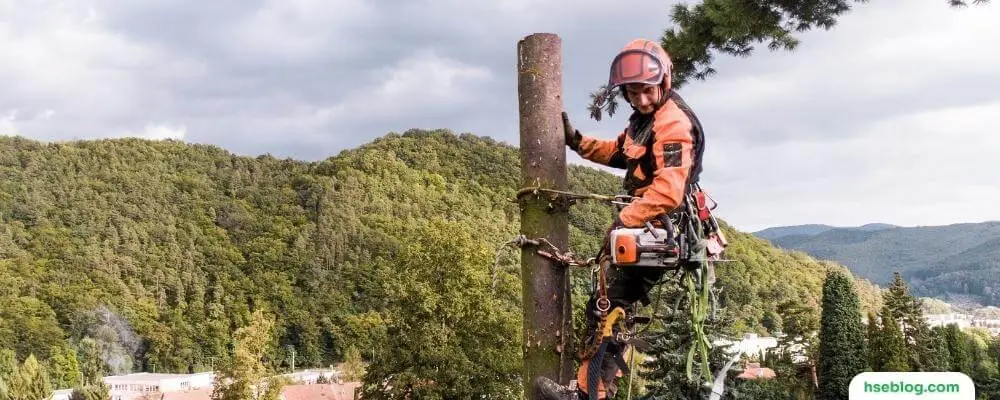
Photo: HSE
READ ALSO: Inside Chicago’s 11 Most Dangerous Neighborhoods: A Closer Look At Safety Challenges
15 Most Dangerous Jobs:
- Commercial Fishermen: With a fatality rate of 77.4 per 100,000 workers, commercial fishermen brave hazards from slippery decks to vessel disasters. Weather-related incidents contribute significantly to the high fatality rate, emphasizing the need for stringent safety measures.
- Logging Workers: The logging industry, with a fatality rate of 128 per 100,000, exposes workers to risks from falling trees, machinery mishaps, and challenging terrains. Proper PPE and adherence to safety protocols are crucial safeguards.
- Aircraft Pilots and Flight Engineers: Pilots face unpredictable weather conditions and technical malfunctions, making their profession one of the most challenging. With a fatal injury rate of 48 per 100,000, they must stay alert, follow safety checks, and undergo regular training.
- Roofers: Roofing, with a fatal injury rate of 41 per 100,000, poses risks from falls and tool-related accidents. Safety measures such as guardrails and proper tool handling are essential for roofers’ well-being.
- Refuse and Recyclable Material Collectors: Ranked as the seventh deadliest job, collectors face traffic hazards and exposure to harmful substances. Wearing PPE and practicing safe lifting techniques are crucial for minimizing risks.
- Structural Iron and Steel Workers: Working at significant heights and handling heavy materials, iron and steel workers face falls and injury risks. Proper safety equipment and adherence to protocols are vital.
- Delivery and Truck Drivers: Truck drivers encounter road accidents and dangers during loading and unloading. Adequate rest, defensive driving, and strict adherence to regulations are essential safety measures.
- Farmers, Ranchers, and Other Agricultural Managers: Machinery accidents and livestock handling pose unique risks to those in agriculture. Thorough training, proper equipment, and safety protocols are essential safeguards.
- First-line Supervisors of Construction Trades: Supervisors oversee on-site safety compliance and coordinate hazardous tasks. Rigorous safety checks, regular meetings, and emergency protocols are crucial for accident prevention.
- Electrical Power-Line Installers and Repairers: Facing electrocution hazards and working at heights, electricians need proper training and safety equipment. The fatal injury rate of 24.2 per 100,000 underscores the importance of precautionary measures.
- Miners: Miners confront respiratory hazards, fall risks, entanglement hazards, explosion risks, and noise exposure. A fatal injury rate of 25.4 per 100,000 emphasizes the need for comprehensive safety measures.
- Underwater Welders: Combining welding and diving skills, underwater welders face a death rate 40 times higher than the national average. Adequate training and safety equipment are crucial for minimizing risks.
- Oilfield Workers: Operating in hazardous environments, oilfield workers face risks from vehicle crashes and other dangers. Improved safety measures are essential across all aspects of oilfield operations.
- Bull Riders: The sport of bull riding comes with fame but also significant risks. Athletes face a rising trend in injuries, highlighting the high-risk nature of the profession.
- Police Officers: While not in the top ten, police officers encounter serious dangers, with a notable increase in homicides. The distinct risks associated with law enforcement underscore the need for continuous safety measures.
READ ALSO: Exploring The Real Los Angeles: 10 Toughest Neighborhoods Beyond The Glitz
Post Views: 0
In this article:Dangerous jobs 2023,High-risk professions,Most perilous occupations,Occupational hazards,Workplace safety standards

Click to comment



![Tyson Foods Plant [Photo: Food Manufacturing]](https://southarkansassun.com/wp-content/uploads/2023/08/iStock_1185520857__1_.5e441daa51cca-600x337.jpg)








![Silverado Senior Living Management Inc. [Photo: Los Angeles Times]](https://southarkansassun.com/wp-content/uploads/2023/10/download-6-4-600x337.jpg)

![China's Wuhan Institute of Virology [Photo: Nature]](https://southarkansassun.com/wp-content/uploads/2023/09/d41586-021-01529-3_19239608-600x337.jpg)















